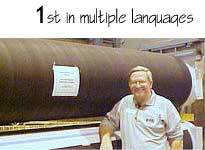Jim Thompson (jthompson@taii.com)
Week of 24 Aug 2009
Click here, then click "Trans lator" in top navigation bar for other languages.
![]()
This past Sunday afternoon, Y. E. Yang, up until that moment the 110th ranked professional golfer in the world, knocked off Tiger Woods to win the 91st PGA Championship in Chaska, Minnesota, USA. Congratulations to Mr. Yang and his homeland of South Korea. This was a deja vu moment for me.
In 1983, at the tail end of another recession, the challenger Australia II, for the first time by anyone in 132 years, won the America's Cup, sailing's most prestigious award, from the United States, who actually had the trophy bolted to a table at the New York Yacht Club. It was, needless to say, a low point in US prestige, even if you were a landlubber like me.
In May 1969, after several attempts by several teams and drivers over the previous three or four years, Mario Andretti, driving a turbine powered car owned and developed by the STP Corporation, literally blew away the competition to win the Indianapolis 500 auto race. The rules making body promptly banned turbine-powered race cars. And a recession was looming just around the corner.
Recessions and technological change seem to go together.
In this column a couple of weeks ago, your humble writer suggested we set a goal of reducing the weight of a paper machine by half by 2025. This simple suggestion has unleashed a torrent of emails. Look at last week's letters column as well as this week's and you will see what I mean.
The only conclusion possible from the evidence of these pent-up ideas is that our funding of research and development is flawed. This leads to the obvious question, why is it flawed? The answer seems to be this--at one point, the pulp and paper industry went from being a growth industry to a stable industry and then to a stagnant one in some grades. CEO's, under pressure to keep up the bottom line, cut out the future by cutting out R & D. This becomes a vicious circle: no R & D, no new products, no new products, lower growth rates and on and on and on.
We pacified ourselves by letting the government fund our research, at least here in the United States. This may have worked to some extent in the energy end of the business, but it is foolishness at the paper machine end. Simply, the US no longer has a major paper machine manufacturer, the kind with the really deep pockets that can absorb large R & D investments. The foolishness is to possibly think any government anywhere is going to fund the development of machinery largely manufactured in another country. It is just not going to happen.
Now the governments, at least in the US and Canada, are directly subsidizing the industry with tax credits for burning black liquor. We are becoming the agricultural industry. If one reads agricultural magazines, one is as likely to find references to how to exploit the latest government subsidies as they are to find an article on new or improved technologies. This is not a path to success.
I have been up close and personal with a number of university and research led enterprises in the last few years. I'll bluntly say they are flawed, too, for many of their scientists merely play the game of luring in more funding. Accomplishing anything would mean they would have to think up a new, untested idea to market for funding. It is safer to just keep putting the same old ideas into new and improved packaging, something like you would do with soap. For survival, scientists have become salespersons. And nothing is accomplished.
It is not that there is a shortage of risk money for funding research and development. Look at the Internet Bubble of the late 1990's. People and enterprises risked huge amounts of money on the hope they would be able to strike it rich. Compared to the pulp and paper industry, though, the Internet Bubble had a great advantage: no history. People were willing to gamble on an idea whose past was a clean slate. Mess up, however, and funding is reticent.
I am going to continue to push the lightweight machine idea, for it seems to have merit and there seems to be latent energy hiding in the bushes, just waiting for the right mixture of ideas and enterprise in order to blossom. At the same time, I will continue to explore funding and organizational ideas to make it happen.
By the way, the Australia II had several innovations: a carbon fiber boom, Kevlar sails, and a winged keel. There are some lessons for us in these materials.
There is hope. Coincidentally, the morning after Mr. Yang defeated Mr. Woods, my wife and I were sitting in the dining room at the DeSoto Hilton in Savannah, Georgia. As she used a tea bag, I noticed its function was quite unusual. It was a Tetley "drawstring" tea bag, which has a clever drawstring mechanism to expel the liquid from the spent bag. Humble tissue paper with an innovative touch--an inspiration for us all.
For safety this week, let us remember that while innovation is often very, very good, we must always test it for safety, in every meaning of the word. Installing a tank, process system or any other item in our mills without a thorough safety analysis is inviting disaster.
Be safe and we will talk next week.
